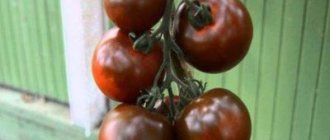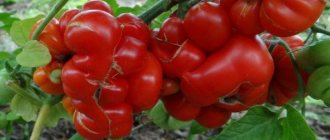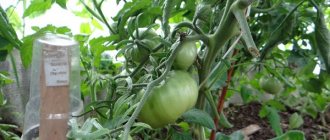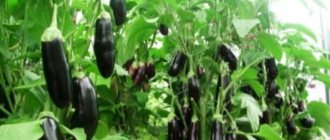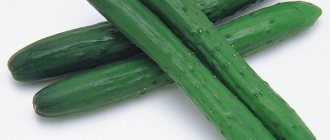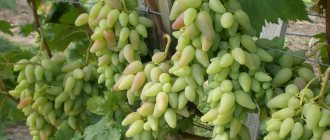Description of the tomato variety Black Baron
Black Baron tomatoes are a large-fruited variety with a dark color. The plant is indeterminate, forms a powerful tall bush, which requires staking and formation into 1-2 stems. The leaves are green, medium in size, high foliage. The inflorescence is simple, the first one is formed above the 7-8 leaf.
In the characteristics and description of the Black Baron tomato variety, the average ripening period is stated - 120 days pass from full germination to harvest.
The fruits of the variety are flat-round in shape, with medium ribbing at the stalk. When unripe, tomatoes are green with a green spot at the base. Ripe fruits acquire a brown-chocolate hue.
According to the internal structure, tomatoes of the Black Baron variety are multi-celled, having more than 6 nests. The weight of one fruit reaches 250 g. The skin is thin but durable, which makes tomatoes easy to store and transport.
Diseases and pests
There are a large number of varieties of diseases found in nightshades. Among the most dangerous are blossom end rot, Alternaria blight and the most common - late blight.
Important ! Overmoistening of the soil is the most common cause of disease.
The Black Baron variety is quite resistant to diseases and has good immunity, but preventive measures will not hurt at all. Let's consider the main causes and methods of preventing diseases.
Apical rot
The first sign of the disease is the appearance of watery spots on the tomatoes, which quickly grow and acquire a brown tint. The main causes of blossom end rot are temperature changes and lack of calcium in the soil. Excess nitrogen and high humidity also increase the likelihood of disease development.
For treatment, the leaves of the diseased plant are treated with a solution of calcium chloride.
Adding calcium as part of complex mineral fertilizers will be a good preventative measure.
Alternaria blight
Signs of the development of Alternaria include the appearance of small (up to 1 cm in diameter) dry gray spots. They appear first on the lower leaves. The disease then progresses and spreads to the entire plant.
A diseased bush will have to be treated with fungicides (for example, Kuproksat, Infinito).
Prevention of the disease consists of disinfecting the seeds and soil before planting, for example, with a strong solution of potassium permanganate.
Late blight
The causative agent of late blight is a fungus that first settles on the leaves in the form of grayish-brown spots and then consumes the entire plant.
When humidity is high, fluffy plaque grows. After spots appear on the fruit, the tomato rots. The main factors for the development of the disease are temperature changes, high humidity and rainy weather. On sunny days the disease is rare.
Late blight will be slowed down in the early stages only by fungicides (chemical: “Bordeaux liquid”, “Ridomil”; biological: “Fitosporin”, “Ecosil”) and the removal of affected leaves, and in the advanced stage - the entire plant.
As a preventive measure:
- regularly spray the bushes with fungicides (for example, biological) as soon as the temperature drops below +15 degrees;
- remove and burn diseased leaves;
- pick green fruits for ripening.
For disinfection, the removed fruits are kept for 1-2 minutes in water at a temperature of 60 degrees.
Pros and cons of the Black Baron tomato variety
Tomato Black Baron is a young variety of Russian selection. Tomatoes are distinguished by their high sugar content, dessert taste, and evenness of the fruit.
Other advantages of the variety:
- large size, regular round shape of the fruit;
- rich color of the peel and pulp;
- sweet, honey taste;
- high vitamin value;
- excellent yield;
- resistance to typical tomato diseases;
- good keeping quality and transportability.
The difficulties of the variety that a gardener may encounter include: the complex formation of the bush, as well as its spreading nature and the need to allocate enough space for the growth of the crop and the ripening of large fruits.
Advantages and disadvantages
Among the main advantages of the variety:
- high taste of tomatoes;
- the fruits are well stored;
- it is possible to use fruits in cooking, canning;
- resistance to diseases.
The disadvantages include:
- the need for careful formation of the bush;
- heavy branches need support;
- the plant requires abundant feeding.
Optimal growing conditions
The plot for growing Black Baron tomatoes is prepared in advance. The culture grows well after cabbage, legumes or cucumbers. Sandy or loamy soils with neutral acidity are suitable for cultivation. Tomatoes will not develop in acidic soil, so lime or dolomite flour is added to it in the previous season.
For growing Black Baron tomatoes, it is best to build a warm, high bed, which consists of layers of organic matter and soil. A high bed warms up faster and remains warm, which is especially important for the root system of tomatoes. After all, when the roots come into contact with cold soil, the plants stop growing.
Advice! When growing tomatoes in open ground, it is important to install temporary shelters in case of a sudden cold snap.
The place for growing is chosen to be cultivated so that the adjacent area is also cleared of weeds. Tomato bushes should be ventilated, but without drafts or strong gusts of wind. Tall Black Baron tomatoes are planted in a direction from north to south so that the bushes receive enough sunlight.
Growing tricks: advice from experienced summer residents
Let's list a number of useful tips and tricks shared by experienced gardeners. With their help, it is easier to achieve a stable tomato harvest at your summer cottage.
Tips and Tricks:
- When removing stepsons, leave a small stump of 2-3 cm, then a new stepson will not grow from the sinus.
- To keep the humidity in the greenhouse lower, water the plant through a bottle buried next to the bush. This way the soil will be dry and crumbly, and moisture will flow directly to the roots.
- To prevent late blight in the greenhouse, place 2-4 open bottles of iodine. Its vapors effectively fight fungus.
- Before planting seedlings, disinfect the bed with a strong solution of potassium permanganate.
- If dark spots appear on the leaves and fruits, apply potassium fertilizers to increase the plant's immunity and solve the problem.
- If aphids appear on the leaves, wash them off with warm water and green soap.
- Slugs are afraid of ammonia. To solve this problem, spray the leaves and soil around the stem with an aqueous solution of alcohol.
- Flying insects do not like strong odors. They will be scared away by a tincture of chamomile, garlic or celandine.
Growing
The Black Baron tomato is grown through seedlings. Sowing begins in February-March, depending on the location of cultivation and the climatic characteristics of the region.
At the seedling stage, the crop is grown for about 60 days, adding to this a week for the emergence of seedlings.
The further growth and fruiting of the crop in open ground depends on the quality of the seedlings. Therefore, to obtain a high yield, only strong seedlings with thick stems, large leaves and a well-formed root system are replanted.
Growing seedlings
Single-sized seeds without damage are selected for sowing. To prevent diseases, seeds, including those collected independently, are disinfected by soaking in a fungicide solution.
The soil for cultivation is highly fertile, loose, without foreign inclusions. Before planting, it is disinfected, loosened and watered. When sowing in common containers, the seeds are placed in grooves at a distance of 2 cm from each other. The grooves are marked with a distance of 4-5 cm. When sowing in separate cassettes or cups, place 2 seeds in one hole in each container. In both cases, the seeds are buried no more than 1.5 cm. The crops are covered with fertile soil on top and sprayed with a fine sprayer.
Seeds germinate at a temperature of +25ºC. When seedlings appear, the plants are transferred to the brightest place. During the first 4 days, round-the-clock supplementary lighting is provided with special lamps. With a lack of lighting, the sprouts weaken and stretch, which further leads to slower growth and fruiting. At the same time, the temperature is lowered to +18ºC, which promotes the development of the root system.
After the first two true leaves appear, the plants are transplanted into containers with a large volume of soil.
Landing rules
Depending on the shape of the tomato, a planting scheme is chosen. The crop needs a sufficient feeding area, so for plants that are supposed to be grown in one stem, the distance between the bushes is kept at 60 cm, and for 2 stems - 80 cm.
Important! The seedlings are transferred to open ground by transshipment while preserving the earthen clod.
The hole is pre-watered abundantly. Bone meal is well suited as an organic fertilizer when planting Black Baron tomatoes. The additive gradually releases nutrients and does not deplete or oversaturate the soil with various elements.
Watering and fertilizing
During the growing period, large-fruited Black Baron tomatoes remove a lot of nutrients from the soil. Therefore, the crop needs 3-4 complex feedings during the growing season.
Watering for tomatoes requires uniform watering; drip watering is considered the best. Water the tomatoes with heated water without chlorine. The method of mulching the soil, which is covered with dry grass or black and white newspapers, helps to reduce watering and maintain looseness of the soil.
Pinching and tying
The Black Baron tomato variety is characterized by unlimited stem growth and large fruits, so the plant needs a garter. To prevent the plant from breaking under the weight of the fruit, it is necessary to tie up both the stems and the fruit clusters.
Advice! The stem is tied immediately after transplantation with a free loop to the stakes, as well as with twine and trellises.
During the growing season, the plant forms many side shoots - stepsons, which must be removed to prevent their growth. The shoot is broken out or cut off, leaving a stalk a few centimeters in size to stop re-growth.
Stepchildren are best removed in the morning so that the resulting wound has time to heal during the day. When using a garden tool, be sure to disinfect it and remove healthy plants first, and then those with signs of disease.
Formation
When forming a Black Baron tomato, all emerging stepsons are cut off into one stem. When forming into 2 stems, one strong stepson is left, which will later become the second stem. The remaining stepsons are removed completely. Also, during the growth period, the stem is gradually freed from the lower leaves, removing 1 piece at a time. in Week. It is especially important to remove leaves that come into contact with the soil to avoid fungal diseases.
At the end of the season, the growth of the stem is forcibly stopped by pinching the top above the last leaf. Thus, the plant will stop forming fruit clusters, and all its energy will be spent on ripening the fruits.
Protection from diseases and pests
The Black Baron tomato is resistant to many diseases. But under unfavorable weather conditions, bushes can be affected by various types of fungi. For prevention, spraying with “Fitosporin” is used, the soil is treated with “Trichodermin”.
Pests in the form of caterpillars and leaf beetles are collected manually, and they are also sprayed with Fitoverm on the leaf.
How to grow black tomatoes on your plot?
The agricultural technology of black tomato varieties is no different from growing red analogues. Like other tomatoes, the plant is provided with regular watering, weeding and fertilizer.
Features of growing and caring for the variety
The Black Baron variety has an indeterminate stem that is not limited in growth. The height of the plant reaches 150 centimeters or more. In this regard, the trunk must be secured to a support. To avoid breaking off, clusters with large fruits should also be tied up.
Preparation of seedlings
Seeds are planted for seedlings 50-60 days before the intended planting in a permanent place of growth. Seeds are sown for germination in a common box to a depth of no more than 1-1.5 centimeters. For faster germination, seed treatment with growth stimulants is useful.
After opening 1-2 true leaves, the sprouts are pricked, that is, transplanted into an individual container in which they grow until planted in the ground.
The optimal temperature for growing seedlings during the day is 20-25 degrees, at night - not lower than +18 degrees.
Water the seedlings after the top layer of soil has partially dried and do not allow moisture to stagnate at the roots. It is better to water in the morning, since waterlogged soil at night will cause hypothermia of the roots. Plants will get sick or even die.
Reference . For good seedling growth, phosphorus-potassium fertilizers are used.
Landing rules
At the age of 60-65 days, after stabilization of positive night temperatures, the seedlings are transplanted to a permanent place. No more than 3-4 plants are placed on one square meter. The distance between plants is at least 50 cm, row spacing is at least 60 cm.
Add humus to the planting hole and pour it well with not very cold water. After planting, the seedlings are not watered for a week. The moisture added during planting will be sufficient.
On a note . The deeper the seedlings are planted, the more additional roots are formed on its stem.
Rules of care
The main task of the gardener in caring for the Black Baron is to correctly form the bush. The variety is tall and must be grown on a support or tied to a trellis or greenhouse.
The bush is formed into one or two stems. To do this, leave the lower stepson on the main plant. Subsequently, this place must be covered with earth, then the stepson will form its own independent root system. All other stepchildren must be removed!
Important ! For healthy roots, the plant needs access to oxygen. To do this, the soil around the plant is kept loose and a hard crust is not allowed to form.
Do not forget to regularly remove weeds, because they take nutrients from the cultivated plant. In addition, weeding promotes loosening and additional aeration of the soil.
All large tomatoes require additional fertilizers, since the plant requires a lot of effort to grow large fruits. During the period of increasing green mass and growth of a young plant, tomato requires fertilizers with a high nitrogen content.
After the plant enters the flowering and fruiting period, the amount of nitrogen is reduced, giving preference to the potassium-phosphorus composition.
Watering
In order for the fruits to grow large, regular watering is important, but you should not allow the soil to become waterlogged. One or two deep waterings per week is sufficient.
It is better to water adult plants, like seedlings, early in the morning, so that the earthen ball has time to dry out a little during the day.
If tomatoes grow in a greenhouse, it must be ventilated, because, unlike cucumbers, tomatoes do not like too humid air. Constant moisture on the leaves will provoke the growth of fungi and putrefactive bacteria.
General information
Hybrid Black Baron f1 is famous for its high yield. Caring gardeners collect more than 3 kg of large fruits from each plant. The bushes grow throughout the warm season, so the variety must be regularly pinched and the stems tied to strong supports. To get the maximum yield of good fruits, you should leave only two stems on one bush.
Here's how to raise your vibrational frequency in your daily life
The first inflorescence is formed above the 7th or 8th leaf. By the way, the foliage of the Black Baron is of an unusual emerald color.
According to the description, the color of the fruit is chocolate or dark burgundy. They are round in shape, and slightly ribbed near the stalk - see photo.
Vitamin-rich Baron tomatoes are delicious fresh. You can also preserve them, prepare all kinds of seasonings from them, or make juice.
A little about the origin of the hybrid
Among inexperienced gardeners there is an opinion that dark tomatoes are genetically modified. Actually this is not true. In our country, such tomatoes were grown when nothing was known about genetic engineering.
Dark tomatoes were bred by amateur breeders, so these wonderful vegetables were rare in Soviet times. They were not particularly popular due to the lack of proper information. Today, the State Register includes a number of dark varieties of tomatoes.
As for the Black Baron specifically, he was bred by Dutch breeders. Fortunately, this hybrid has taken root well in most regions of our country, including the Urals and Siberia. Reviews from gardeners living there confirm this. In colder latitudes, these tomatoes are grown in greenhouses.
Reviews
In their reviews, gardeners who tried to grow the Black Harrow variety noted both its positive and negative features.
Among the positive points:
- the fruit fully corresponds to the characteristics and photos declared by the manufacturer;
- high seed germination;
- delicious fleshy fruits;
- reviews of the Black Baron tomato confirm the stated yield of over 5 kg per bush.
Among the negative features:
- Ripe tomatoes need quick processing because they are not stored for a long time.
- Some gardeners have had problems with the ovaries falling off. However, it is difficult to know what the real reason was, since it also occurs due to a lack of nutrients, watering with cold water or high humidity.
